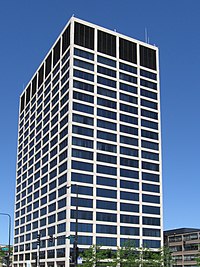
Photo from wikipedia
This paper aims at experimental and numerical research of delamination process in carbon/epoxy composite laminates with different fiber orientation angles in stacking sequence exhibiting the bending–twisting elastic couplings. Experimental specimens… Click to show full abstract
This paper aims at experimental and numerical research of delamination process in carbon/epoxy composite laminates with different fiber orientation angles in stacking sequence exhibiting the bending–twisting elastic couplings. Experimental specimens were subjected to the double cantilever beam (DCB) tests according to the ASTM D5528 regulations. Values of the mode I strain energy release rates were calculated by using three different data reduction schemes: the modified beam theory, the compliance calibration method and the modified compliance calibration. Determination of delamination initiation point was conducted in twofold way: by visual observation of crack tip using high resolution camera and by utilization of the acoustic emission technique. Numerical analyss were prepared in Abaqus/CAE Software environment by using the virtual crack closure technique (VCCT). The numerical beam model consisted of SC8R continuum shell elements. Obtained outcomes revealed that extensive fiber bridging phenomenon occurring during delamination process pronouncedly affected propagation values of strain energy release rate (GIprop) and numerically obtained load–displacement curves. Nevertheless, in initial stage of delamination, results obtained by using the VCCT were in agreement with experimental data. The greatest value of the mode I fracture toughness equal 0.56 N/mm was obtained for the BT45 laminate.
Journal Title: Materials
Year Published: 2022
Link to full text (if available)
Share on Social Media: Sign Up to like & get
recommendations!